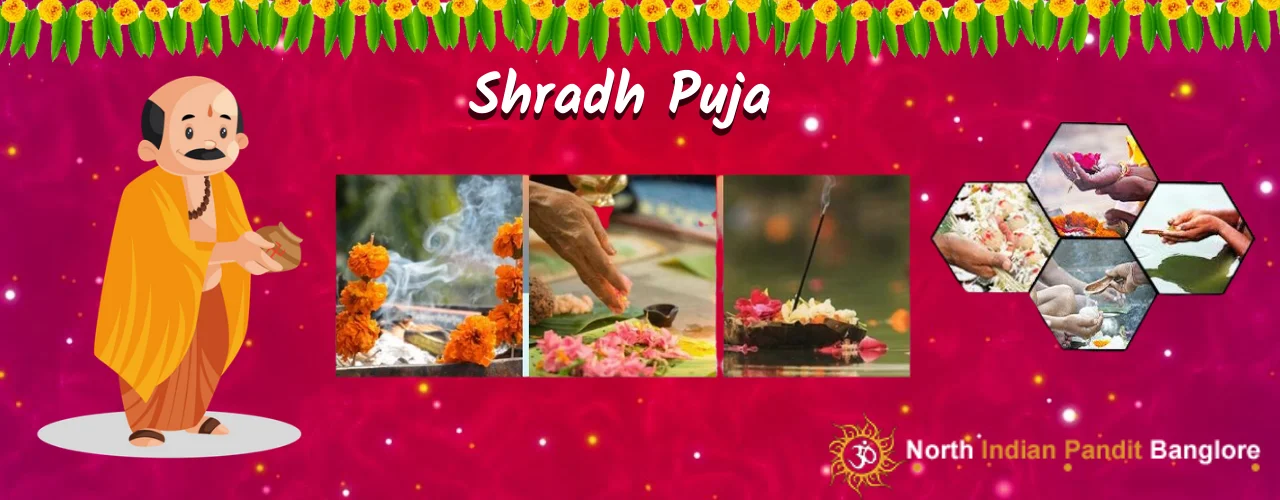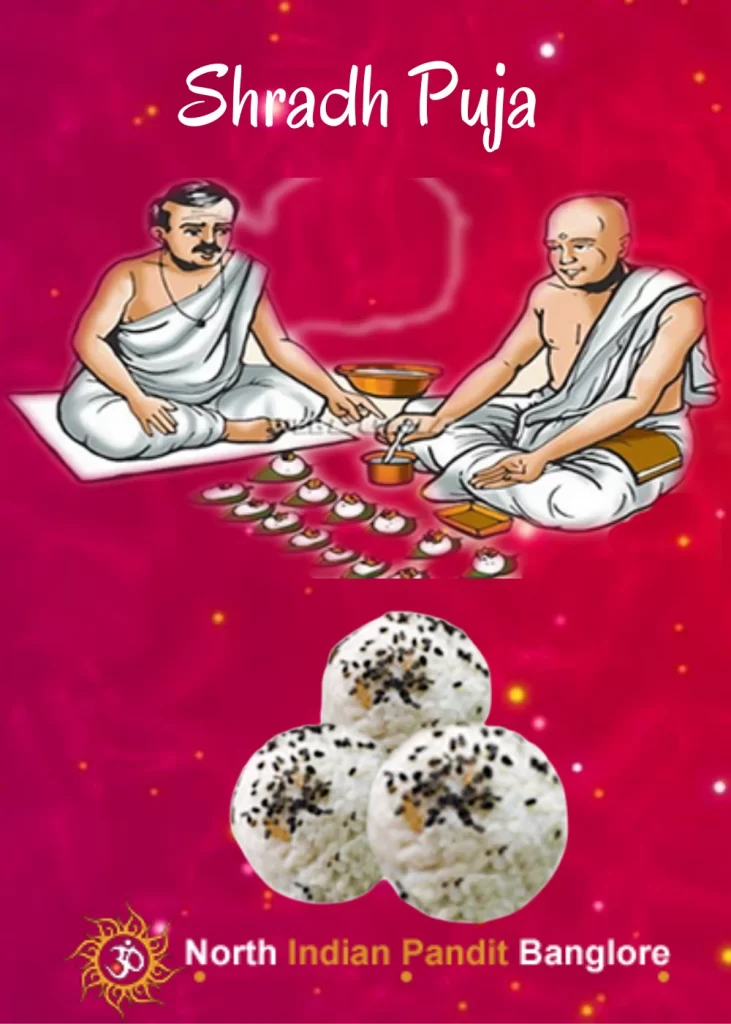+91 7760241176
Give Us A Call
contact@northindianpuja.com
Drop Us a Line
No. 14 1st main Ambedkar Nagar, viveknagar post, 3rd Stage, Koramangala, Bengaluru, Karnataka 560047
Office Location

Shradh is an important Hindu ceremony. It is a Puja to the departed ancestors’ salvation (atma shanti) (paternal as well as maternal). It is an expression of respect and loyalty to ancestors.
It will bring good fortune to their descendants and so positive energies for advancement. The descendent is also blessed materially by the pitra/forefathers. As material hurdles or issues are removed, the individual can advance spiritually. This puja is incredibly effective and heals major ailments. This is done to heal chronic diseases and other body aliments. Those who are always sick should perform this pooja for quick recovery. This puja is for Business or Career Success, and Protection from Evils and Enemies.

QUICK TO CALLBACK
The most important parts of Shraddha rituals are:
Vishwadeva Sthapana (विश्वेदेव स्थापना)
Pindadan (पिण्डदान)
Feeding the Brahmin (Tarpan)
Pindadan is the act of giving rice, cow’s milk, ghee, sugar, and honey to the ancestors in the shape of a pinda (a round heap). Pandadan should be done with all your heart, devotion, feelings, and respect for the soul of the person who died.
Tarpan is an offering of water that has been mixed with black sesame, barley, kusha grass, and white flour. People think that Tarpan makes the spirits of the dead happy.
To finish the Shraddha ritual, you must feed the Brahmin. Before food is given to a Brahmin, it is also given to the crows.
Tarpan: ‘Trup’ means ‘please’. Trup is the root word for ‘Tarpan’. Tarpan is the act of offering water to God, Sages, ancestors’ souls, and humans.
Hand position during Tarpana
Hand stance when offering Tarpana to devas (Gods, Goddesses, and Navagrahas), rishis (sages), and pitrus (departed ancestors).
(a) The offering for devas flows across the right hand’s four fingers save the thumb.
(b) For rishis, the offering is made to flow between the wrist and the little finger on the left side of the palm.
(c) For the pitrus, the offering flows over the right side of the palm and the thumb.
The forefathers’ shraddha and tarpan are important. People from Pitar Dev Swargalok are supposed to visit their ancestors. Those who do not offer sacrifices or shraadh to their ancestors are thought to face Pitru-dosh. This flaw creates various problems. So, to appease the fathers, certain actions are restricted in Pitrupaksha. The scriptures say Pitra Devas can appear in any shape in Pitrupaksha. So, do not disrespect any animal or human who enters the house. Upon entering, give food and respect to all. There is a specific reverence for ancestors in pilgrimage places. Ancestors are said to be saved by shraddha in Gaya, Badrinath, or Prayag. Those who do not have to do Shraddha at a specific location may do it at any of the house’s holy places. At the end of Pitripaksha, crows are considered sacred since not giving them to the grass completes the shraddha karma. It’s not just 1, it’s incomplete. Shivra and Pitru Paksha is the period between Bhadrapada’s full moon and Ashwin’s new moon. Shraddha Paksha is a father-pleasing festival. During these 16 days (Shraddha Paksha), food is fed to the gods, cows, dogs, crows, and ants. The cow is sacred to all Gods and Goddesses. The dog and crow are the ancestor’s shape in the Pitra Paksha, hence the feeding law. At this time, the crows are particularly revered, as it is thought that without grass, the shraadha karma is incomplete. The fathers are said to be honoured in the Krishna Paksha of Ashwin month. During this time, gifts are made to the fathers.
QUICK TO CALLBACK
If you’re planning a puja or other religious celebration, you can consult this list of experienced pandits for recommendations. The pandits recite in a variety of languages, including Bengali, Hindi and English. Your puja/occasion experience will be hassle-free if you book the pandit you choose at a reasonable price and let us take care of the rest.
Welcome to NorthIndianPuja.com, your ultimate destination for authentic North Indian pandits in Bangalore! Are you seeking the perfect pandit for your upcoming puja? Look no further! Our platform offers seamless pandit booking services, ensuring a hassle-free experience for all your religious ceremonies.
Whether it’s a traditional Hindu puja or a special occasion, our handpicked Hindi pandits in Bangalore are adept at performing rituals with precision and devotion. With their expertise and proficiency, they bring a touch of authenticity to every ceremony, making it truly memorable.
Say goodbye to the stress of finding a reliable pandit in Bangalore. With NorthIndianPuja.com, you can easily browse through our curated list of pandits, select the one that suits your requirements, and book their services with just a few clicks.
Experience the convenience of accessing top-notch pandit services right at your fingertips. Trust NorthIndianPuja.com for all your puja needs in Bangalore and make your religious ceremonies truly divine!
Give Us A Call
Drop Us a Line
Office Location

Northindianpuja.com provides the best Pandit in Bangalore services for your puja requirements at home or at the office. We have the best Vedic Hindi Purohits and North Indian Panditji available in Bangalore to do all types of pujas and homas for you.
We provide Pandits and Purohits services in Bangalore areas such as Whitefield, Hebbal, Marathalli, Sarjapur road, KR Puram, Banasavadi, Yeshwanthapuram, Rajajinagar, Malleshwaram, Jayanagar, Basavanagudi, Srinagara, Girinagara, Vijaynagar, AECS Layout, HAL, Bellandur, HSR Layout, HRBR Layout & other areas also.
Presented By Chaahna Associates